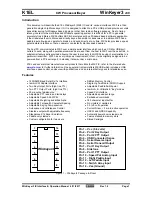
32
CNT-SVX05A-EN
Sequence of operation
Space temperature setpoint operation
The controller has three sets of possible heating and cooling setpoints:
• Occupied
• Occupied standby
• Unoccupied
In unoccupied mode, the controller always uses locally stored default
unoccupied heating and cooling setpoints. These setpoints are configured at the
factory prior to shipment. Use Rover™ service tool to modify these default
unoccupied setpoints.
Table 21 — Setpoint operation
Space temperature setpoint selection
Internal and external setpoint adjustment
Zone sensors with an internal or external setpoint adjustment (1k
Ω
) provide the
Tracer
™
AH.540 controller with a local setpoint (50° to 85°F or 10° to 29.4°C).
An internal setpoint adjustment is concealed under the zone sensor’s cover.
To access the adjustable setpoint wheel, remove the zone sensor cover. An
external setpoint (when present) is accessible from the zone sensor’s front cover.
When the hardwired setpoint adjustment is used to determine the setpoints,
all unit setpoints are calculated based on the hardwired setpoint value, the
configured setpoints, and the active mode of the controller.
Example:
Assume the controller is configured with the following default
setpoints:
Absolute Setpoint Offset = Setpoint Input – Mean Setpoint
From the default setpoints in this example, the mean setpoint is the mean of the
occupied cooling and heating setpoints, which is 72°F [(74+70) / 2]. The absolute
setpoint offset is the difference between the setpoint input and the mean
setpoint.
Method
Used in these situations:
Zone sensor (with an
adjustable, hardwired
setpoint)
A hardwired, adjustable setpoint is connected to the controller
on IN 2. Local setpoints are enabled in the unit configuration.
No communicated setpoint is present.
Communicated source
A setpoint is communicated to the controller, typically from a building
automation system or a peer controller. If both a hardwired setpoint and
a communicated setpoint exist, the controller uses the communicated
value. The configuration feature for enabling/disabling the local setpoint
does not affect the setpoint handling when communicated setpoints are
used. The communicated setpoint always takes priority over the set-
pointhardwired setpoint, even when the local setpoint is enabled.
Stored default setpoints
The controller uses the locally stored default heating and cooling
setpoints when neither a local hardwired setpoint nor communicated
setpoint is present. When a building automation system is present,
the controller uses the default setpoints when no setpoint is
communicated to the controller and no hardwired setpoint exists.
The controller uses stored default setpoints when only a local setpoint
exists, but the local setpoint is disabled in the configuration of the
controller. The controller always uses the stored default (unoccupied)
setpoints in unoccupied mode.
Unoccupied cooling setpoint
85°F
Occupied standby cooling setpoint
76°F
Occupied cooling setpoint
74°F
Occupied heating setpoint
70°F
Occupied standby heating setpoint
66°F
Unoccupied heating setpoint
60°F
















































